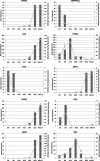Gene expression profiling of postnatal lung development in the marsupial gray short-tailed opossum (Monodelphis domestica) highlights conserved developmental pathways and specific characteristics during lung organogenesis
- PMID: 30290757
- PMCID: PMC6173930
- DOI: 10.1186/s12864-018-5102-2
Gene expression profiling of postnatal lung development in the marsupial gray short-tailed opossum (Monodelphis domestica) highlights conserved developmental pathways and specific characteristics during lung organogenesis
Abstract
Background: After a short gestation, marsupials give birth to immature neonates with lungs that are not fully developed and in early life the neonate partially relies on gas exchange through the skin. Therefore, significant lung development occurs after birth in marsupials in contrast to eutherian mammals such as humans and mice where lung development occurs predominantly in the embryo. To explore the mechanisms of marsupial lung development in comparison to eutherians, morphological and gene expression analysis were conducted in the gray short-tailed opossum (Monodelphis domestica).
Results: Postnatal lung development of Monodelphis involves three key stages of development: (i) transition from late canalicular to early saccular stages, (ii) saccular and (iii) alveolar stages, similar to developmental stages overlapping the embryonic and perinatal period in eutherians. Differentially expressed genes were identified and correlated with developmental stages. Functional categories included growth factors, extracellular matrix protein (ECMs), transcriptional factors and signalling pathways related to branching morphogenesis, alveologenesis and vascularisation. Comparison with published data on mice highlighted the conserved importance of extracellular matrix remodelling and signalling pathways such as Wnt, Notch, IGF, TGFβ, retinoic acid and angiopoietin. The comparison also revealed changes in the mammalian gene expression program associated with the initiation of alveologenesis and birth, pointing to subtle differences between the non-functional embryonic lung of the eutherian mouse and the partially functional developing lung of the marsupial Monodelphis neonates. The data also highlighted a subset of contractile proteins specifically expressed in Monodelphis during and after alveologenesis.
Conclusion: The results provide insights into marsupial lung development and support the potential of the marsupial model of postnatal development towards better understanding of the evolution of the mammalian bronchioalveolar lung.
Keywords: Lung; Marsupial; Monodelphis domestica; RNA-seq.
Conflict of interest statement
Ethics approval
Animal Ethics approval ID 1112115 from the University of Melbourne Animal Ethics committee (Anatomy & Neuroscience, Pathology, Pharmacology and Physiology).
Consent for publication
Not applicable.
Competing interests
The authors declare that they have no competing interests.
Publisher’s Note
Springer Nature remains neutral with regard to jurisdictional claims in published maps and institutional affiliations.
Figures







Similar articles
-
3D reconstruction of the bronchial tree of the Gray short-tailed opossum (Monodelphis domestica) in the postnatal period.J Anat. 2023 Dec;243(6):910-935. doi: 10.1111/joa.13928. Epub 2023 Jul 27. J Anat. 2023. PMID: 37497834 Free PMC article.
-
Development of the terminal air spaces in the gray short-tailed opossum (Monodelphis domestica)- 3D reconstruction by microcomputed tomography.PLoS One. 2024 Feb 16;19(2):e0292482. doi: 10.1371/journal.pone.0292482. eCollection 2024. PLoS One. 2024. PMID: 38363783 Free PMC article.
-
Molecular characterisation and expression of CD4 in two distantly related marsupials: the gray short-tailed opossum (Monodelphis domestica) and tammar wallaby (Macropus eugenii).Mol Immunol. 2007 Jul;44(15):3641-52. doi: 10.1016/j.molimm.2007.04.013. Epub 2007 May 22. Mol Immunol. 2007. PMID: 17521733
-
Gamete biology of the new world marsupial, the grey short-tailed opossum, Monodelphis domestica.Reprod Fertil Dev. 1996;8(4):605-15. doi: 10.1071/rd9960605. Reprod Fertil Dev. 1996. PMID: 8870084 Review.
-
Gestation and placentation in two New World opossums: Didelphis virginiana and Monodelphis domestica.J Exp Zool. 1993 Aug 1;266(5):463-79. doi: 10.1002/jez.1402660511. J Exp Zool. 1993. PMID: 8371092 Review.
Cited by
-
Epigenetic clock and methylation studies in marsupials: opossums, Tasmanian devils, kangaroos, and wallabies.Geroscience. 2022 Jun;44(3):1825-1845. doi: 10.1007/s11357-022-00569-5. Epub 2022 Apr 21. Geroscience. 2022. PMID: 35449380 Free PMC article.
-
3D reconstruction of the bronchial tree of the Gray short-tailed opossum (Monodelphis domestica) in the postnatal period.J Anat. 2023 Dec;243(6):910-935. doi: 10.1111/joa.13928. Epub 2023 Jul 27. J Anat. 2023. PMID: 37497834 Free PMC article.
-
Didelphis albiventris: an overview of unprecedented transcriptome sequencing of the white-eared opossum.BMC Genomics. 2019 Nov 15;20(1):866. doi: 10.1186/s12864-019-6240-x. BMC Genomics. 2019. PMID: 31730444 Free PMC article.
-
Postnatal development in a marsupial model, the fat-tailed dunnart (Sminthopsis crassicaudata; Dasyuromorphia: Dasyuridae).Commun Biol. 2021 Sep 2;4(1):1028. doi: 10.1038/s42003-021-02506-2. Commun Biol. 2021. PMID: 34475507 Free PMC article.
-
Development of the terminal air spaces in the gray short-tailed opossum (Monodelphis domestica)- 3D reconstruction by microcomputed tomography.PLoS One. 2024 Feb 16;19(2):e0292482. doi: 10.1371/journal.pone.0292482. eCollection 2024. PLoS One. 2024. PMID: 38363783 Free PMC article.
References
-
- Weir BJ, Rowlands IW. Reproductive strategies of mammals. Annu Rev Ecol Syst. 1973;4:24. doi: 10.1146/annurev.es.04.110173.001035. - DOI
-
- Tyndale-Biscoe CH, Janssens PA. The developing marsupial : models for biomedical research. Berlin: Springer-Verlag; 1988.
-
- Burton GJ, Barker DJP, Moffett A, Thornburg K. The placenta and human developmental programming. Cambridge: Cambridge University Press; 2010.
MeSH terms
Grants and funding
LinkOut - more resources
Full Text Sources
Molecular Biology Databases

